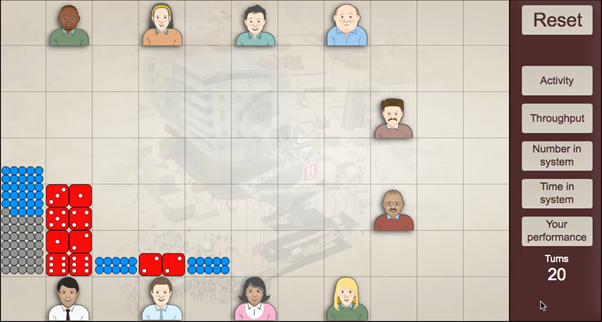Game 2
Resource reallocation
Click "start" on the above to begin.
An introduction and review of the game is given below.
An introduction and review of the game is given below.
In this second dice game we can explore the impact of resource flexibility on both throughput and work in progress. This is simply achieved by clicking and dragging dice from one resource to another before you roll the dice for the next move. There is no restriction to the number of dice you can load on each resource prior to each roll. This gives you total flexibility of resource, simulating an environment where any resource can carry out any job!
It is suggestion is that you try a number of different strategies to see if you can improve your performance relative to the first unmanaged game. I am sure you will have great fun trying to dynamically reallocate resources dependent upon the latest outcomes. Inevitably, there may be a time when you allocate lots of dice to a particular resource and yet the overall throughput is lower than you had hoped. That’s just the throw of the dice!
It is suggestion is that you try a number of different strategies to see if you can improve your performance relative to the first unmanaged game. I am sure you will have great fun trying to dynamically reallocate resources dependent upon the latest outcomes. Inevitably, there may be a time when you allocate lots of dice to a particular resource and yet the overall throughput is lower than you had hoped. That’s just the throw of the dice!
Game 2 behaviour and analysis
When you can control the resources and allocate the dice freely you can find strategies that allow you to improve over the unmanaged game. In the example below, 65 people have been processed through the system in 20 rounds.
 This might be a victory over 20 rounds, but in reality, operations aren’t finite in duration; what happens over the next 20 rounds?
You can see that the management strategy used above has left little work in progress in the system. In fact, the first 7 of the 9 queues are empty. In order to get more people through the system over the next 20 rounds you will have to start again and build up the work in the system. Having to do this will mean that it is likely that your subsequent throughput will be lower. What is required is a process of continuous improvement that will result in
This might be a victory over 20 rounds, but in reality, operations aren’t finite in duration; what happens over the next 20 rounds?
You can see that the management strategy used above has left little work in progress in the system. In fact, the first 7 of the 9 queues are empty. In order to get more people through the system over the next 20 rounds you will have to start again and build up the work in the system. Having to do this will mean that it is likely that your subsequent throughput will be lower. What is required is a process of continuous improvement that will result in
 This might be a victory over 20 rounds, but in reality, operations aren’t finite in duration; what happens over the next 20 rounds?
You can see that the management strategy used above has left little work in progress in the system. In fact, the first 7 of the 9 queues are empty. In order to get more people through the system over the next 20 rounds you will have to start again and build up the work in the system. Having to do this will mean that it is likely that your subsequent throughput will be lower. What is required is a process of continuous improvement that will result in
This might be a victory over 20 rounds, but in reality, operations aren’t finite in duration; what happens over the next 20 rounds?
You can see that the management strategy used above has left little work in progress in the system. In fact, the first 7 of the 9 queues are empty. In order to get more people through the system over the next 20 rounds you will have to start again and build up the work in the system. Having to do this will mean that it is likely that your subsequent throughput will be lower. What is required is a process of continuous improvement that will result in- Increased throughput
- Reduced work in progress
- Shorter lead times through the system